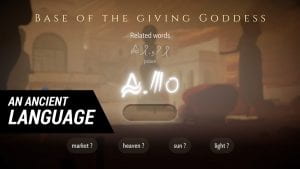
Heaven’s Vault is a narrative adventure game spanning the science-fiction and ancient history genres. Produced and Developed by Inkle Studios, the game was first released on 15th April 2019 (Inkle Studios, n.d.a). The game is available on PlayStation 4, Microsoft Windows and Nintendo Switch. I purchased it on sale at Steam for $17.97 AUD at a 52% discount (full cost is $35.95 AUD) (Steam, n.d.).
InkleStudios. (2019, January 23). Heaven’s vault – official trailer. [Video]. YouTube. https://www.youtube.com/watch?v=RUgtMlkwXRA
The player guides protagonist Aliya Elasra (Figure 1) amongst a futuristic collection of planets called the Nebula. Through a third person view the player ‘sails’ Aliya’s spacecraft Nightingale through space rivers between planets (Figure 2) to solve the disappearance of a leading roboticist from the University on the governing planet Iox. Aliya is accompanied by the artificially intelligent robot Six (Figure 3). Whilst on each planet Aliya puts her archaeological knowledge to the test to uncover artefacts from a now-forgotten past and decipher the language Ancient, a hieroglyphic language developed specifically for the game. Heaven’s Vault’s developers have created over 1000 unique words, with glyphs inspired by Ancient Egyptian and Chinese writing systems (Figure 4).




The game uses Ink; a narrative scripting language created by Inkle studios to create choice based interactive fiction (Inkle Studios, n.d.b). Heaven’s Vault uses Ink in a unique way; every choice the player makes, including their interactions with other characters is remembered and adapted by the game. The player has control over the narrative; choosing who to interact with, when and the attitudes towards each character, including conversations with her companion, Six. Six provides background details into the history and political context of the alliance of planets in the Nebula. Aliya can choose how much interaction she has with Six, thereby allowing the player to control how deeply they ‘read into’ or engage with the background behind the story. This allows a more immersive experience than a traditional print book would offer.
The design of the game features sleek 3D animation whilst each character is represented as hundreds of hand-drawn 2D characters providing the familiarity of a comic book in an immersive world; helping to bridge the gap between traditional print and digital literatures. This is highlighted as the dialogue is represented through speech bubbles, further integrating traditional and digital literature (Figure 5). There are cut scene breaks where Aliya soliloquises her thoughts and experiences, where subtitles are presented at the bottom of the screen; further bringing the comic book style to life (Figure 6). This also allows the player to hear her voice, further immersing the story experience. However, her upper-class English accent is incongruent to her poor upbringing, the otherworldly setting of the game and the North African and Middle Eastern influences in the game’s style.


Aliya investigates sites and analyses ancient monuments to find artefacts and discover new hieroglyphs. The player is presented with the puzzle of matching similar shapes to possible related meanings. Each time a key event occurs such as the discovery of a new glyph, the event is added to the game’s timeline (Figure 7). A map allows for easy navigation, overcoming a challenge of digital environments (Figure 8)(Jabr, 2013). The player can access the timeline and scan through from recent events right through to ancient history of the game universe. This presents players, particularly students, with the unique ability to experience the more practical or abstract aspects of studying history they would otherwise have limited access to in a classroom setting (Massey, 2015). This allows for the potential to use this game in an educational context to allow greater understanding and engagement with the subject.


The PC edition of the game uses standard WASD keys for movement, however, navigating movement whilst simultaneously selecting dialogue options can be tricky. The camera perspective, which “provides the interactive window through which we experience the game” determines the degree of freedom and immersion the player has within the game (Rougeau, 2017, para. 3). The camera movement and controls were at times difficult to manoeuvre which caused some frustration leading me to utilise my mouse instead of my laptop touchpad. Diegetic sound and background music is used primarily to enhance the immersion in the environment and evoke emotional responses such as anticipation or to foreshadow key events. Although there is arguably greater potential for sound to be used in more creative ways, vision is typically the primary sense favoured in transmedia storytelling (Cowdy, 2018, p. 25; Roskos et al., 2014). Furthermore, the combination of multimodal sources enhance the narrative and enable a greater empathetic connection with the text (Cowdy, 2018).
Overall, Heaven’s Vault provides an excellent interactive digital literature experience for both students and casual players alike.
References
Cowdy, C. (2018). Grammars of new media: Interactive trans-sensory storytelling and empathic reading praxis in Jessica Anthony and Rodrigo Corral’s Chopsticks. Bookbird: A Journal of International Children’s Literature, 56(1), 20-27. https://doi.org/10.1353/bkb.2018.0003
Heaven’s vault (PC version) [Video game]. (2019). Inkle Studios.
Hetfeld, M. [Malindy Hetfeld] (n.d.). Heaven’s vault review. Wireframe. https://wireframe.raspberrypi.org/articles/heaven%27s-vault-review
Inkle Studios. (n.d.a). Heaven’s vault. https://www.inklestudios.com/heavensvault/
InkleStudios. (2019, January 23). Heaven’s vault – official trailer. [Video]. YouTube. https://www.youtube.com/watch?v=RUgtMlkwXRA
Inkle Studios. (n.d.b). Ink: a narrative script language for games. https://www.inklestudios.com/ink/
Jabr, F. (2013, April 11). The reading brain in the digital age: The science of paper versus screens. Scientific American. http://www.scientificamerican.com/article/reading-paper-screens/
Massey, S. (2015). The Multidimensionality of children’s picture books for upper grades. The English Journal, 104(5), 45-58. Retrieved August 18, 2021, from http://www.jstor.org/stable/24484579
Nufafitc. (2020, July 12). Indie adventures: “Heaven’s Vault” (PC). Emotional Multimedia Ride. https://emotionalmultimediaride.wordpress.com/2020/07/12/indie-adventures-heavens-vault-pc/
Roskos, K., Burstein, K., Shang, Y., & Gray, E. (2014). Young children’s engagement with e-books at school: Does device matter? SAGE Open. https://doi.org/10.1177/2158244013517244
Rougeau, M. [Mike Rougeau] (2017, April 3). Why video game cameras seem to always suck. Remember Super Mario 64? Mashable. https://mashable.com/article/video-game-cameras-suck
Steam. (n.d.). Heaven’s vault. https://store.steampowered.com/app/774201/Heavens_Vault/
TVTropes. (n.d.). Video game/ heaven’s vault. https://tvtropes.org/pmwiki/pmwiki.php/VideoGame/HeavensVault